-
Documentation
-
About
- Getting Started & Use Cases
- Support
-
What's New
- Simplified tools for designing with contour lines
- DynamicFlood: Organize and understand your computations
- Modelling stormwater networks in Scalgo Live
- National US high-resolution land cover map
- New functionality for CAD users!
- DynamicFlood: Cleaning up rain events and adding historical rains, now available in France
- National Polish high-resolution land cover map
- DynamicFlood now available in Great Britain
- Global contour maps now available
- Updated Swedish topsoil map
- Scalgo Live Global theme is updated with new elevation and land cover data
- Detailed culvert information in DynamicFlood
- No more Lantmäteriet fees for Swedish data
- Depth-dependent surface roughness (Manning) in DynamicFlood
- Detailed land cover map for all of Great Britain
- National French high-resolution land cover map
- Work with multiple features simultaneously in the canvas
- Spill points on flash flood map and depression map
- New surface roughness (Manning) parameters for DynamicFlood
- Workspace and Modelspace sharing updates
- Regionally varying rain in DynamicFlood Sweden
- Veden imeytyminen nyt osana rankkasadeanalyysejä
- Use Scalgo Live anywhere in the world
- DynamicFlood: Live model speed info and regionally-varying rain events
- Sea-level rise: Download building flooding information
- Detailed contour maps and editable buildings in Workspaces
- New in Modelspaces: Explore hydrodynamic simulations and visualise the dynamics of flow velocity
- National German high-resolution land cover map
- Specify basins and protrusions by drawing their outer boundary
- Simplified path features
- National Norwegian high-resolution land cover map
- Organise and communicate on a digital canvas
- New sidebar to help organize your analyses and queries
- Sliding contours
- Ny skyfallsanalys och en ännu bättre marktäckekarta
- New land cover map for Finland
- Depths in the depression map
- New Danish land cover map with more classes
- National Swedish High-Resolution Impervious Surface Mapping
- Watershed tool updated with even better descriptions of catchment characteristics
- National Flash Flood Map with Infiltration and Drainage for Denmark
- Add your own WMS layers to SCALGO Live
- Enriched building data in Denmark
- National hydrological corrections and Land Cover for Poland
- National hydrological corrections for Norway
- Updated Impervious Surface Mapping for Denmark
- National hydrological corrections and updated local data for Finland
- Fast and intuitive tools to work with infiltration and land use
- Improvements to vector imports and exports
- National Danish groundwater model
- New Sweden high-resolution model
- New powerful depression map and more analyses visualization options
- Introducing Modelspaces: Get your hydrodynamic models into SCALGO Live
- Use case videos
- Access a EA flood maps inside SCALGO Live
- Improved map export
- New powerful ways to edit the elevation model
- Better coloring of flooding layers and sea-level depth filtering
- National Danish High-Resolution Impervious Surface Mapping
- National access for local and regional organizations
- Simpler, more powerful downloads
- Customize Layer Transparency
- Hydrological corrections and new data in Sweden
- Improved export functionality
- Access a wide range of authorative data inside SCALGO Live
- Importing VASP data
- Measure gradients, undo edits, and Norway updates
- New terrain edit features, soil balance information and much more...
- Browse historical orthophotos in SCALGO Live
- Emergency planning with sea-level rise from national forecast data
- Detailed information about watershed composition
- Better styling of imported vector layers
- New Danish Elevation Model
- Work with gradients in the profile widget
- Flood risk screening from rivers and flow paths
- New workspace tool: Raise and lower terrain uniformly
- Importing LandXML TINs, LAS point clouds
- New model in Sweden
- Side slopes on workspace features
- Drag and drop enhancements
- Swedish contour maps
- Subsurface basins and sewage drains in workspaces
- New Interface
- Volume information for watersheds and flow paths
- New powerful tool for emergency response and coastal flood prevention
- Denmark: New flash flood map
- Sweden: Geodatasamverkan setting for Swedish users
- Import custom terrain models
- New Hydrological Corrections
- Elevation contours now available
- Download orthophotos as JPEG and PNG
- Subsurface structures in workspace
- Sea-levels in terrain profiles
- Updated orthophotos
- Models and analysis update
- User interface updates
- User interface updates
- GeoDanmark/FOT data, Matrikelkortet now available
- New flash flood map
- Download of risk polygons
- Updated orthophotos
- Nationwide hydrology on the new DHM/2015 model now available
- New flash flood map computation available with watershed download
- DHM/2015 variants and sea-levels now available nationwide
- DHM/2015 now available nationwide
- Hydrology on the new DHM/2015 model now available
- New DHM/2015 Model - now with buildings
- New DHM Model
- Watershed Tool
- Ad hoc layers
- Nationwide contour maps for all countries
- Single Sign-On
- Data Fees
- User Interface
- Canvas
- Analysis
- Workspaces
- Modelspaces
- Working with CAD data
- Core+ DynamicFlood
- Core+ NatureInsight
- Core+ PropertyResilience
- Streams and Flow
- Physical Properties
- Country Specific
-
About
Workspaces – Creating and Managing Workspaces
Workspaces let you change the terrain and observe how the changes affect flood risk, e.g. by adding a levee directly in SCALGO Live or by uploading construction plans from other GIS tools. This enables you to find the best solutions suitable to prevent flooding. When using workspaces, you have to choose whether you want to work with flooding in relation to sea-level rise or flash flooding.
You can always change which analysis you want to run during configuration. This enables you to work with both types of analyses in your workspace.
Note that workspaces are standalone and effects of water crossing the workspace boundary are not considered. Therefore it is important that you create your workspace large enough to avoid issues across the boundary. For instance you should consider the watershed of your project area for flash flood map workspaces and be sure to include the necessary dikes and similar structures for sea-level rise computations.
Standard workspace creation
- Select the workspace tool in the toolbar.
- Select the type of analysis you want to work with, either Flash Flood Map or Sea-Level Rise.
- Select your workspace area. You can select an area by marking a squared or an arbitrary polygon.
- If you regret your first drawing, select clear selection to redraw the desired area or pull directly in one of sides of the polygon to change its size or form.
- Name the workspace (it is by default named after a road in the workspace).
- Select create workspace.
Once created, you can interactively edit the elevation in the workspace area using a variety of different tools.
Advanced workspace creation
There are two advanced ways of creating a workspace:
- Import an existing raster model to SCALGO Live by selecting import and browse your PC. See more about importing rasters in the section called importing existing terrain data.
- Use an existing terrain model based directly on one of our elevation models by selecting existing model.
- Now, select your workspace area. You can either choose to mark a square, or an arbitrary polygon.
- Name the workspace.
- Select your desired elevation model under elevation in the dock by selecting the editing button

You can also specify a boundary polygon for workspace creation and downloads by dragging a vector file (GeoJSON, GeoPackage, Shapefile, Tab) onto the creation/download dialog.
Workspace Dialog
The workspace dialog enables you to edit the workspace features as well as computing the workspace analysis (see next section). The dialog is automatically opened when you create a new workspace, and can also be opened from the dock by clicking on the hammer icon that appears when hovering over the workspace in the dock.
The dialog consists of three tabs that allows you to edit and explore information about your workspace. The first of these is the Elevation tab that contains the various tools needed to editing the workspace elevation model.
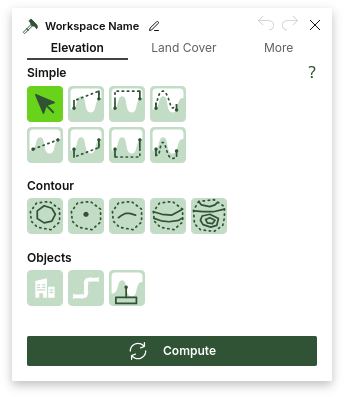
The second is the Land Cover tab that allows modifying the list of land cover types as well as the tool to modify the land cover layer of the workspace.
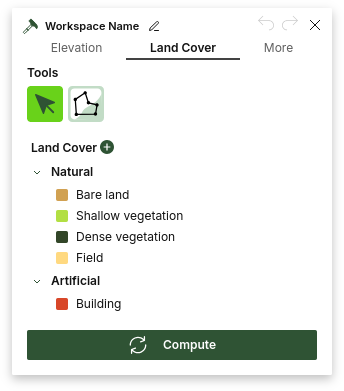
The final tab contains information about the workspace and actions available on the workspace. Of particular interest is the soil information section. This tells you how much soil has been removed or added relative to the original workspace elevation model and is used to compute the soil balance - how much soil needs to be brought into the project area (in case of a soil deficit) or transported away from it (in case of a soil surplus).
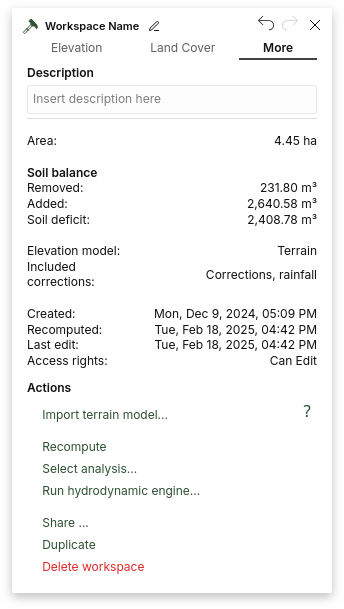
Under the Actions header you will find the following functions,
- Import existing raster model
- Recompute (run analysis)
- Select analysis to compute
- Run hydrodynamic engine (if the DynamicFlood module is available)
- Import corrections (if available and not yet imported)
- Share the workspace
- Duplicate the workspace
- Delete the workspace
NOTE: Based on the settings of your particular workspace, more options than shown above might be available.
The information in the workspace information tab, and on the workspace analyses in the dock can be out of date if you have made changes to the workspace since the last time the workspace analysis was updated. If that is the case we display a big recompute button underneath the workspace dialog. The button is not available if the workspace is up-to-date.
Note that some fields and information will not display if you have read-only access to the workspace you are viewing. If this is the case you will see a banner at the bottom of the workspace dialog like the one shown in the figure below.
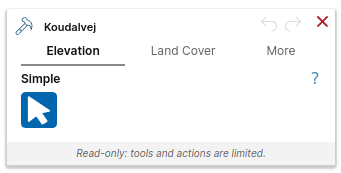
Recomputing and configuring workspaces
Once you have edited your workspace elevation model, you can run analysis on the edited model and quickly see the impact of your changes.
You can configure the parameters to these models directly through the online interface.
To recompute the analysis:
- Select the
icon for the workspace you want to recompute.
- Click the Compute or Recompute button in the bottom of the dialog, if there is no button then all of the information is up to date and no recompute is needed.
You can also recompute the analysis directly from the dock by clicking the green compute icon.
To configure what hydrological analysis tools are run during a recomputation, follow these steps:
- Hit the toolbox icon
for the workspace you want to configure.
- Open the Actions tab
- Click Select Analysis ...
The available configuration options are:
- Sea levels
- Depression volume
- Flash Flood Map (either flow/ Watershed delineation or/and watersheds)
- Flooded analysis (similar to depression-free flow within the workspace)
NOTE: Depending on your setup, other options than those listed above may be available.
Importing corrections
If hydrological corrections are available, and not yet part of your workspace, they can be imported by selecting "Import corrections...". The following screen shows details on the type of corrections available and lets you finalize the import.
To preview the corrections, locate the layer under the "Hydrological Corrections" section in the layer library and enable it. You can find information on the source of the corrections using the info (i) button for the layer.
Share workspace
If you want to share your workspace, select share and a share dialog will appear (as shown below). If you have read-only access to a workspace, you are unable to share that workspace.
Just as when sharing a canvas with other users, you may input the name or email of any Scalgo Live users in the input field at the top or select from users in your organization via the dropdown menu. By toggling the "Can Edit"/"View Only" button, you can set the access permissions for all users in the input field before clicking the Share button.
If you would like to change or remove access permissions for users already added to a workspace, simply click on their access rights to the right of their name and select the desired option.
Note that sharing a workspace will also send a notification email to those you added to the workspace.
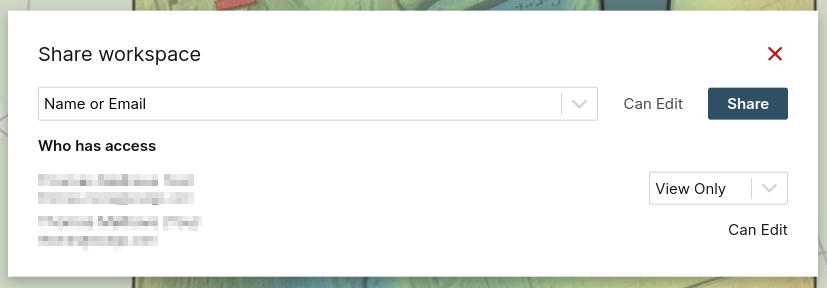
Delete workspace
There are two ways to delete a workspace. You can delete the workspace in the workspace toolbox or through the library.
How to delete a workspace through the workspace toolbox:
- Press delete workspace in the bottom of the toolbox More tab
- Press yes
How to delete a workspace through the library:
- Enter the library and find the particular workspace
- Move your mouse across the workspace
- Press the trash bin on the right side of the workspace name
- Press yes when asked whether to delete permanently
If the workspace is shared with other users, it will only be deleted for the user who actively deletes it. In other words, it will remain available to all other users who share it, regardless of whether they have editor rights or view-only access.
Accessing an existing workspace
If you want to access and edit an active workspace:
- Move your mouse across the workspace in the dock
- Click on the
that appears besides the workspace name.


